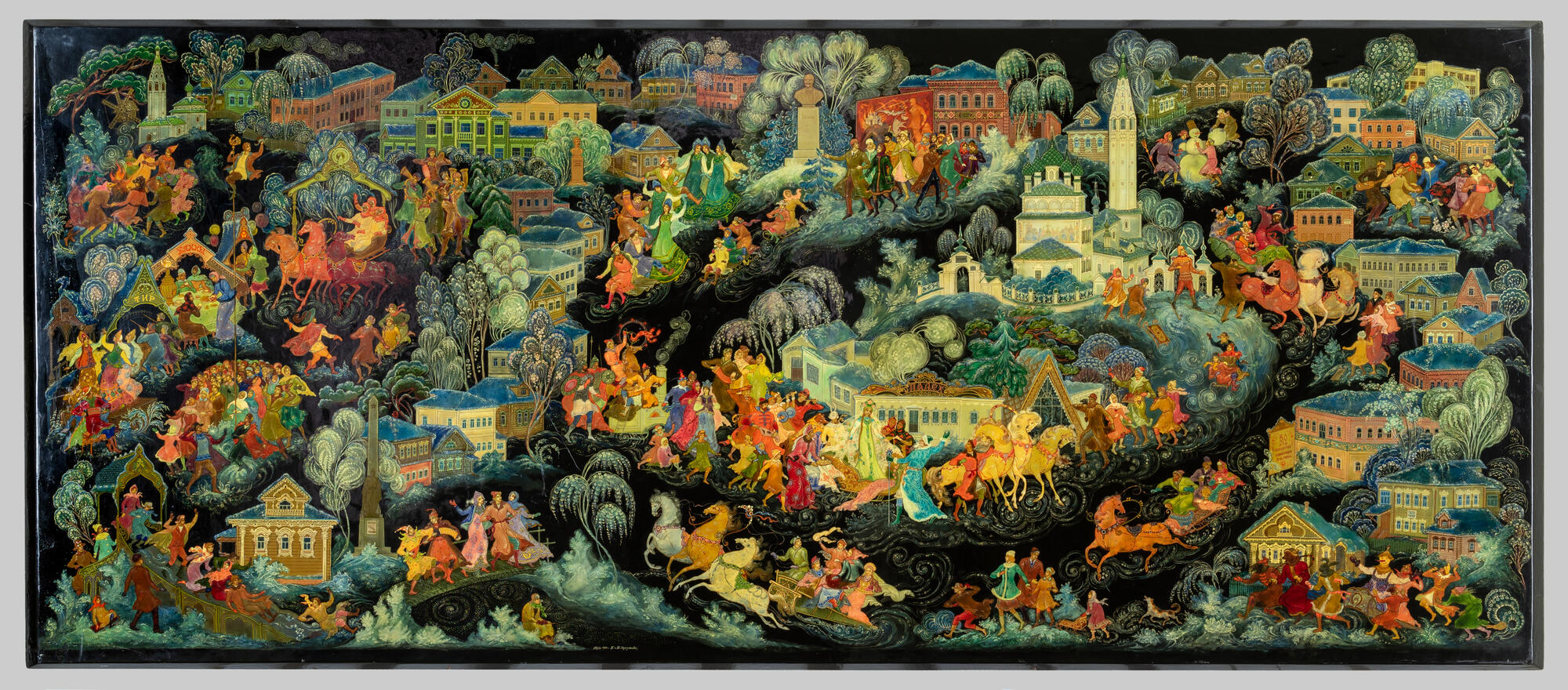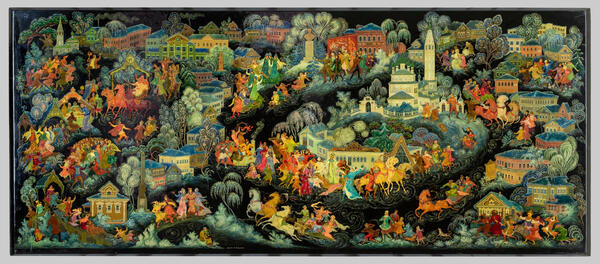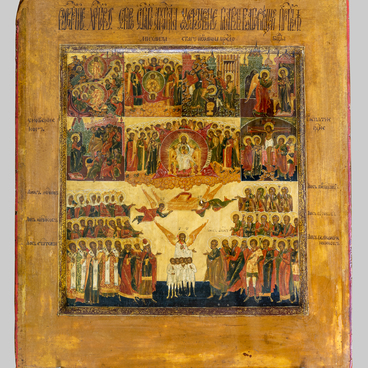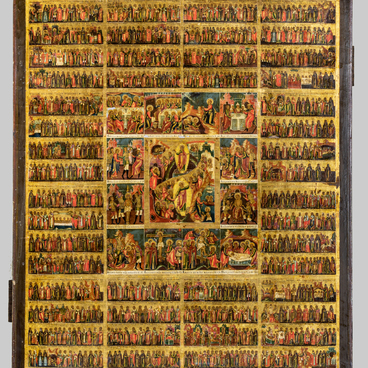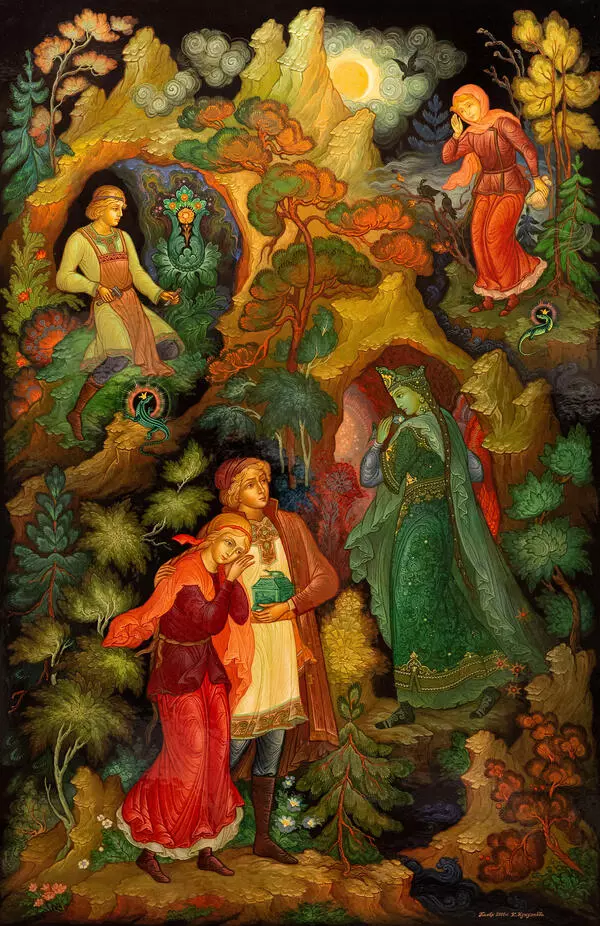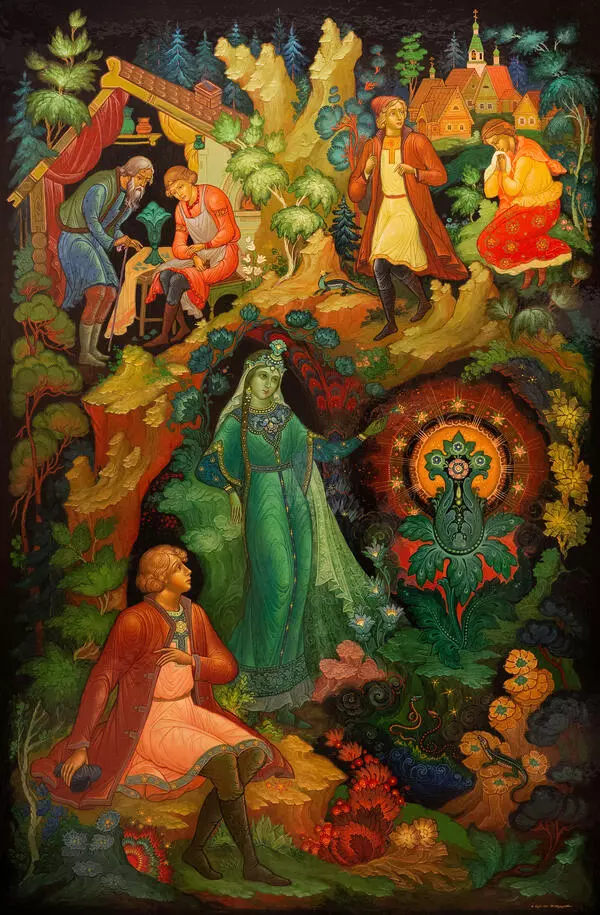The ‘Russian Winter Celebrations in Palekh’ plate was created in 1975. This is a collaborative artwork by the artists Boris Kukuliev and his wife, Kaleria Kukulieva. There are entire artistic dynasties in the Palekh art. Kaleria Vasilievna was born into the Zubkov family, which had a long and proud tradition of icon painting. Her husband, Boris Nikolaevich, arrived to the town from Grozny.
The artists have depicted a memorable event from their youth on this plate. In 1958, the first Maslenitsa celebration was held in Palekh — the folk also call these celebrations ‘a goodbye to Russian Winter.’ Many Palekh residents dressed up as fairytale characters often found in plots depicted on Palekh caskets.
The artists have captured these celebrations in a stylized manner, in line with local traditions. Strict perspectives of the streets of Palekh turned into ornate mazes. The artist built a rhythmic composition, inter-spacing the strict lines of architecture with hills and trees. They depicted the village in a conventional manner rather than realistically — and yet the places they have grown so familiar with are entirely recognizable.
The Holy Cross church — Palekh’s main place of worship and its symbol — stands tall in the centre of the composition. The Kukulievs have accurately depicted its primary architectural forms: its high double-walled volume, its five domes, and the pillar of its hipped bell tower. They depicted the temple decor just as faithfully: tiles, platbands, and the fresco on the eastern wall above the altar. The museum of lacquer miniature which houses all the best artworks by Palekh artists is found in the same fairytale space as the church.
The wooden huts decpicted on the panel are no different than those described by the traveller Dmitry Shelekhov. He visited Palekh in 1842. In his book “A Journey along the Russian Country Roads” he wrote: “The architecture of huts, or peasant houses, is extraordinary… In the village of Palekh, all the houses have windows painted not at all disgustingly — they are pleasing to the eye. There is a special well-lit room on the second floor of each house — it is like an intricately carven toy…”
Some modern items are also present in the composition on the plate, such as statues of Lenin, Golikov, a monument of military glory, and the new building of the Palekh Art School.
A winter landscape was a rare occurence in Palekh miniature. Residents of Palekh prefer painting summer scenes. Openwork crystal trees and snow-white whirlwinds of hills were novel artistic imagery.
The artists have depicted a memorable event from their youth on this plate. In 1958, the first Maslenitsa celebration was held in Palekh — the folk also call these celebrations ‘a goodbye to Russian Winter.’ Many Palekh residents dressed up as fairytale characters often found in plots depicted on Palekh caskets.
The artists have captured these celebrations in a stylized manner, in line with local traditions. Strict perspectives of the streets of Palekh turned into ornate mazes. The artist built a rhythmic composition, inter-spacing the strict lines of architecture with hills and trees. They depicted the village in a conventional manner rather than realistically — and yet the places they have grown so familiar with are entirely recognizable.
The Holy Cross church — Palekh’s main place of worship and its symbol — stands tall in the centre of the composition. The Kukulievs have accurately depicted its primary architectural forms: its high double-walled volume, its five domes, and the pillar of its hipped bell tower. They depicted the temple decor just as faithfully: tiles, platbands, and the fresco on the eastern wall above the altar. The museum of lacquer miniature which houses all the best artworks by Palekh artists is found in the same fairytale space as the church.
The wooden huts decpicted on the panel are no different than those described by the traveller Dmitry Shelekhov. He visited Palekh in 1842. In his book “A Journey along the Russian Country Roads” he wrote: “The architecture of huts, or peasant houses, is extraordinary… In the village of Palekh, all the houses have windows painted not at all disgustingly — they are pleasing to the eye. There is a special well-lit room on the second floor of each house — it is like an intricately carven toy…”
Some modern items are also present in the composition on the plate, such as statues of Lenin, Golikov, a monument of military glory, and the new building of the Palekh Art School.
A winter landscape was a rare occurence in Palekh miniature. Residents of Palekh prefer painting summer scenes. Openwork crystal trees and snow-white whirlwinds of hills were novel artistic imagery.
